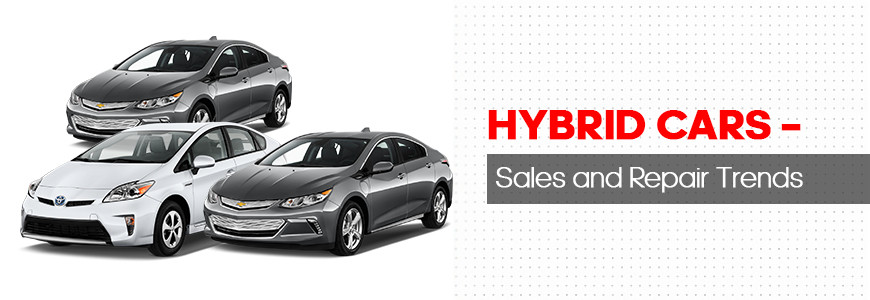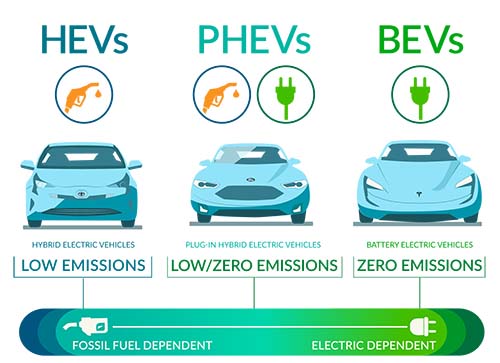Hybrid Cars - Sales and Repair Trends

Before introducing our product - the tester for Ni-MH and Li-ion batteries, let's consider some issues related to the operation of hybrid cars. In general, any vehicle propelled by multiple alternative and independent energy sources falls under the theoretical concept of a "hybrid car." However, hybrid vehicles typically refer to those with a conventional internal combustion engine (usually gasoline, sometimes diesel) and an electric traction motor. The presence of electric motors, one or more, automatically implies the presence of high-voltage batteries (HVB) to power them, leading to certain challenges, such as hybrid battery repair.
Types of hybrid cars, their features, and advantages
Hybrid cars can be divided into several groups, with the two main and most common being:
- FHEV (full hybrid electric vehicle) - a full hybrid where the HVB is charged through regenerative braking from the internal combustion engine.
- PHEV (plug-in hybrid electric vehicle) - hybrid vehicles with high-voltage batteries that can be charged from an outlet, similar to BEVs.
In the first group (mostly older hybrid cars), the ability to move solely on electric power is limited, usually between 5-20 km. The high-voltage battery here mainly assists during acceleration, primarily due to its limited capacity. This limitation is not driven by cost considerations but rather by reliability and practicality concerns.
Smaller batteries are easier to charge, especially through regenerative braking, the most desirable method. However, the initial hybrid models did not have external charging ports, not only due to safety concerns but also to avoid potential negative effects on the battery lifespan caused by human factors.
In FHEVs, a "heartless" controller manages the charging process, preventing the battery from falling below a certain level. As a result, the warranty lifespan of HVB in such vehicles is around 8-10 years or approximately 500,000 km. In reality, with proper usage, the need for hybrid battery replacement or restoration often arises even later.
Despite their advantages, full hybrids have significant drawbacks compared to electric vehicles. The main drawback is that FHEVs have a lower limit on fuel consumption, making it impossible to achieve zero emissions. On the other hand, PHEVs offer owners the ability to travel several tens of kilometers on electric power and then charge the HVB from an external power source.

Prospects for the development of hybrid transport
Global trends in hybrid car sales are mixed. In Europe, particularly in Germany, there has been a significant decline in demand for PHEVs, with a 59% decrease in sales in November 2023 compared to the same period in 2022. However, this situation is more related to the winding down of government support programs than a decrease in consumer interest, which is also evident in the 22% drop in demand for BEVs during the same period.
Meanwhile, in the North American market, where electric vehicle buyers are more actively encouraged, sales are growing not only for BEVs but also for PHEVs. This is evident in the case of Toyota, a pioneer in this field, which continues to prefer hybrids over electric vehicles. According to InsideEVs, plug-in hybrid sales under the Toyota brand increased by 11% in 2023, while Lexus, another brand under Toyota, saw a 69% increase.
Stellantis, offering vehicles under the Chrysler, Jeep, and Dodge brands in the US, achieved the best results in this sector. Sales of its PHEVs grew fourfold, or by 132%, in the past year.
Though estimating the total number of hybrid cars worldwide is challenging, the presented data indicates hundreds of thousands of units sold just last year. Meanwhile, the overall number of xEVs sold last year is estimated at around 13.5 million units.
How to repair hybrid batteries
Sustainable and consistent demand for electric cars implies a demand for services related to their maintenance and repair. While many components of fully electric and hybrid vehicles operate in a gentle mode due to design features (such as the braking system or hybrid internal combustion engine), the high-voltage battery bears the brunt of peak loads and faults.
The HVB in a hybrid, like in an electric vehicle, is one of the most critical components, both in terms of functionality and cost. For a used electric car, it can account for more than half of the residual value. Therefore, we have developed equipment that can be used for repairing hybrid and electric vehicle HVBs. The MS800 can be applied for both diagnostics and balancing of modules, an essential part of hybrid battery restoration. It can also serve as a tester for Ni-MH batteries, primarily used in HEVs, and Li-ion batteries.
What the MS800 can do:
- Diagnose HVB modules, determining their capacity.
- Charge series-connected battery cells.
- Balance modules by voltage.
- Prepare the battery for storage by charging modules to the required level.
Device features:
- 36 separate channels for testing Ni-MH or Li-ion modules.
- Automatic mode.
- Data storage, including on USB storage.
- Touch screen.
- Free software updates.
The MS800 tester is unique equipment for future cars, representing a new era in technical maintenance.







